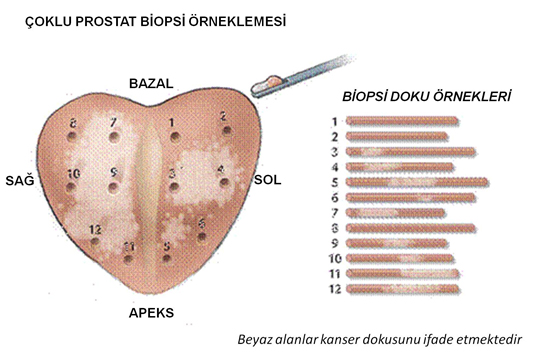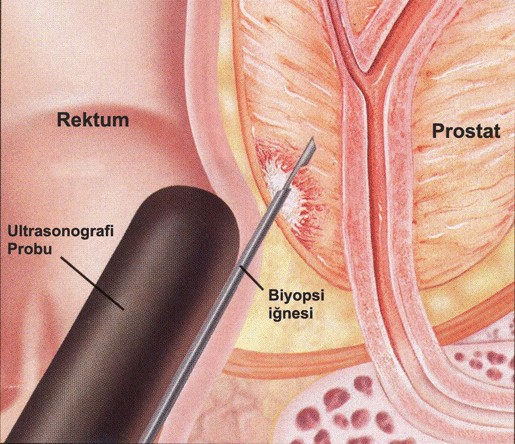1. Who is the prostate biopsy recommended for?
It is performed on males with abnormal mass / stiffness and / or high blood PSA values during a rectal examination with a finger. People who meet the above conditions are candidates after age 50, if they have a family history of prostate cancer after age 40. We do the prostate biopsy from the anus, accompanied by ultrasound.
2. Is biopsy a difficult procedure for patients and physicians?
No.
3. How do we do the biopsy?
By putting the ultrasound probe with a special biopsy needle on the tip from the anus, we first view and plan the prostate gland. We apply local anesthesia to the prostate gland and its environment. Next, we take fine tissue samples from the prostate gland.
We take 12 pieces of 0.5mm diameter, 1-1.5cm length threadlike parts as standard. If there are suspicious foci (nodule, mass) on ultrasound, we can get additional parts from those foci.
It is performed on males with abnormal mass / stiffness and / or high blood PSA values during a rectal examination with a finger. People who meet the above conditions are candidates after age 50, if they have a family history of prostate cancer after age 40. We do the prostate biopsy from the anus, accompanied by ultrasound.
2. Is biopsy a difficult procedure for patients and physicians?
No.
3. How do we do the biopsy?
By putting the ultrasound probe with a special biopsy needle on the tip from the anus, we first view and plan the prostate gland. We apply local anesthesia to the prostate gland and its environment. Next, we take fine tissue samples from the prostate gland.
We take 12 pieces of 0.5mm diameter, 1-1.5cm length threadlike parts as standard. If there are suspicious foci (nodule, mass) on ultrasound, we can get additional parts from those foci.
4. Is a prostate biopsy a long-term procedure?
No. It takes a maximum of 20-25 minutes including local anesthesia.
5. Do I feel pain during the biopsy procedure?
No. Thanks to the local anesthetics we apply - except in special cases - you will hardly feel any pain during the procedure.
6. What should I consider before a prostate biopsy?
Blood thinners (Kumadin, Aspirin, Plavix, etc.) should not be used 5-10 days before the procedure. If you are using cortisone, chemotherapy drugs, if you have heart valve disease, heart murmur, a history of rheumatic fever, and bacterial endocarditis disease (+), you must inform us before the procedure. By the way, you do not need to starve before the procedure, since general anesthesia is not applied.
7. How do we prepare you for biopsy?
We want an enema for bowel cleansing before the procedure. More importantly, we protect our patients with the use of double antibiotics before the procedure in order to prevent urinary tract infection that may develop slightly after the procedure.
No. It takes a maximum of 20-25 minutes including local anesthesia.
5. Do I feel pain during the biopsy procedure?
No. Thanks to the local anesthetics we apply - except in special cases - you will hardly feel any pain during the procedure.
6. What should I consider before a prostate biopsy?
Blood thinners (Kumadin, Aspirin, Plavix, etc.) should not be used 5-10 days before the procedure. If you are using cortisone, chemotherapy drugs, if you have heart valve disease, heart murmur, a history of rheumatic fever, and bacterial endocarditis disease (+), you must inform us before the procedure. By the way, you do not need to starve before the procedure, since general anesthesia is not applied.
7. How do we prepare you for biopsy?
We want an enema for bowel cleansing before the procedure. More importantly, we protect our patients with the use of double antibiotics before the procedure in order to prevent urinary tract infection that may develop slightly after the procedure.
8. Is there a risk of the procedure?
Urine and blood in the ablution after the procedure is a situation we expect in almost all patients and disappears within the first 3 days. In the semen, old blood clots, such as coffee grounds, can be observed even 2-3 weeks after biopsy. These are temporary situations. The issue that concerns you and us the most after the procedure is urinary tract infections, some of which can be seen in 1% of patients, despite the double antibiotic protection applied before the procedure. In such cases, additional intravenous antibiotic therapy may be required under hospital conditions. We do not recommend sexual intercourse for the first 24 hours after the procedure. Rarely, patients with enlarged prostate may develop a stiffness or inability to urinate after the procedure. Treatment is done with a temporary probe. We want you to drink plenty of fluids (8-10 glasses / day) after the procedure. Abundant fluid consumption is very important in terms of not improving the above mentioned complaints.
9. How many days does the prostate biopsy result appear and how is it interpreted?
You get the test result in 2-3 days. A pathologist examines the 12 biopsy pieces taken from the prostate gland under a microscope to evaluate the cells and their alignment. As a result, if the cancer cell is present, it ranks between 3 and 5 according to the cell lineup. He collects these notes in his report and makes a score called Gleason. Gleason scoring: 3 + 3 = 6 (low risk for spread) 3 + 4 = 7 (medium risk for spread) 4 + 4 = 8 or 4 + 5 = 9 (high risk for spread) tumors. Gleason score, such as PSA, is also very important in determining the pre-treatment tests, choosing the treatment method.
10. My biopsy result was negative.
I don't have to do anything else from now on! False! It is possible that the samples taken during the prostate biopsy may not coincide with the cancerous tissue. Therefore, a second biopsy may be needed in cases such as the following.
* When there is a high suspicion in finger examination
* When PSA continues to increase
* When there is an atypical cell in the first biopsy
11. My PSA is high. I did not have a prostate biopsy. What happens
There are different reasons for the height of PSA. We cannot understand why it is high otherwise. Nor can it be understood whether the stiffness or masses detected after finger examination are good or malignant. What if there is cancer? You miss the chance of early diagnosis.
Urine and blood in the ablution after the procedure is a situation we expect in almost all patients and disappears within the first 3 days. In the semen, old blood clots, such as coffee grounds, can be observed even 2-3 weeks after biopsy. These are temporary situations. The issue that concerns you and us the most after the procedure is urinary tract infections, some of which can be seen in 1% of patients, despite the double antibiotic protection applied before the procedure. In such cases, additional intravenous antibiotic therapy may be required under hospital conditions. We do not recommend sexual intercourse for the first 24 hours after the procedure. Rarely, patients with enlarged prostate may develop a stiffness or inability to urinate after the procedure. Treatment is done with a temporary probe. We want you to drink plenty of fluids (8-10 glasses / day) after the procedure. Abundant fluid consumption is very important in terms of not improving the above mentioned complaints.
9. How many days does the prostate biopsy result appear and how is it interpreted?
You get the test result in 2-3 days. A pathologist examines the 12 biopsy pieces taken from the prostate gland under a microscope to evaluate the cells and their alignment. As a result, if the cancer cell is present, it ranks between 3 and 5 according to the cell lineup. He collects these notes in his report and makes a score called Gleason. Gleason scoring: 3 + 3 = 6 (low risk for spread) 3 + 4 = 7 (medium risk for spread) 4 + 4 = 8 or 4 + 5 = 9 (high risk for spread) tumors. Gleason score, such as PSA, is also very important in determining the pre-treatment tests, choosing the treatment method.
10. My biopsy result was negative.
I don't have to do anything else from now on! False! It is possible that the samples taken during the prostate biopsy may not coincide with the cancerous tissue. Therefore, a second biopsy may be needed in cases such as the following.
* When there is a high suspicion in finger examination
* When PSA continues to increase
* When there is an atypical cell in the first biopsy
11. My PSA is high. I did not have a prostate biopsy. What happens
There are different reasons for the height of PSA. We cannot understand why it is high otherwise. Nor can it be understood whether the stiffness or masses detected after finger examination are good or malignant. What if there is cancer? You miss the chance of early diagnosis.




